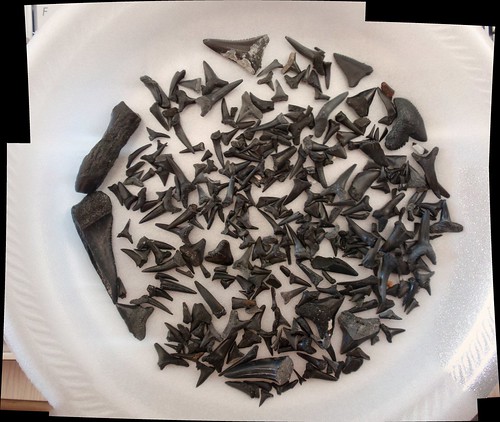Shark Teeth Fossils

Shark Teeth Fossils
Types of Fossil Shark Teeth
By Heather Broeker, eHow Contributing Writer
By Heather Broeker, eHow Contributing Writer
The identification of fossilized shark teeth is a study that requires many hours of study and dedication to the work. Many factors can complicate the identification process, such as sex of the shark and the location of the tooth. In addition, identification is different whether the tooth comes from upper or lower jaw. Many variations of teeth can exist within the same species of shark, so no exact specifications can be set forth about shark teeth. However, some characteristics can give even a casual observer an educated guess on the species of shark.

Carcharocles Megalodon
Carcharocles megalodoneg is said to be the forebearer to modern sharks. Scientists predict it to have been over 50 feet long and to have weighed around 52 tons. The teeth are as large as a man's hand. The teeth are broadly triangular and thick. The teeth also have finely serrated edges with no protrusions. The megalodon is thought to have lived in shallower and warmer waters, it is likely they resided near the equator.
Carcharocles megalodoneg is said to be the forebearer to modern sharks. Scientists predict it to have been over 50 feet long and to have weighed around 52 tons. The teeth are as large as a man's hand. The teeth are broadly triangular and thick. The teeth also have finely serrated edges with no protrusions. The megalodon is thought to have lived in shallower and warmer waters, it is likely they resided near the equator.
Cosmopolitodus Planus
Cosmopolitodus planus is an ancient ancestor of the mako shark. They were found only in the Pacific Ocean. Their teeth were curved, but flattened. The teeth are not serrated. The curve of the tooth extends past the root of the tooth.

Paleocarcharodon Orientalis
Paleocarcharodon orientalis is considered to be the earliest member of the genus Carcharodon. Carcharodon is a closely related species to the great white shark, but this evolutionary branch seems to have died out. These teeth are highly serrated, triangular, but slightly curved.

Otodus Obliquus
Otodus obliquus is referred to as the giant mackerel shark. This shark in some circles is said to be the link between megalodon and the modern great white, in other circles it is said to be an ancestor of the megalodon. The teeth tend to have a protuberance on either side of the main blade of the tooth. The tooth is not serrated, but it is curved slightly.

Carcharocles Chubutensis
Carcharocles chubutensis is similar to the megalodon and represents a subspecies, rather than completely differentiated shark. Some say chubutensis is an ancestor of megalodon, some say it followed megalodon on the evolutionary chain. The tooth is finely serrated and broadly triangular. Chubutensis represents a mutation that probably became a species of shark in the modern age.
Carcharocles chubutensis is similar to the megalodon and represents a subspecies, rather than completely differentiated shark. Some say chubutensis is an ancestor of megalodon, some say it followed megalodon on the evolutionary chain. The tooth is finely serrated and broadly triangular. Chubutensis represents a mutation that probably became a species of shark in the modern age.




Shark Teeth Fossils
Comments